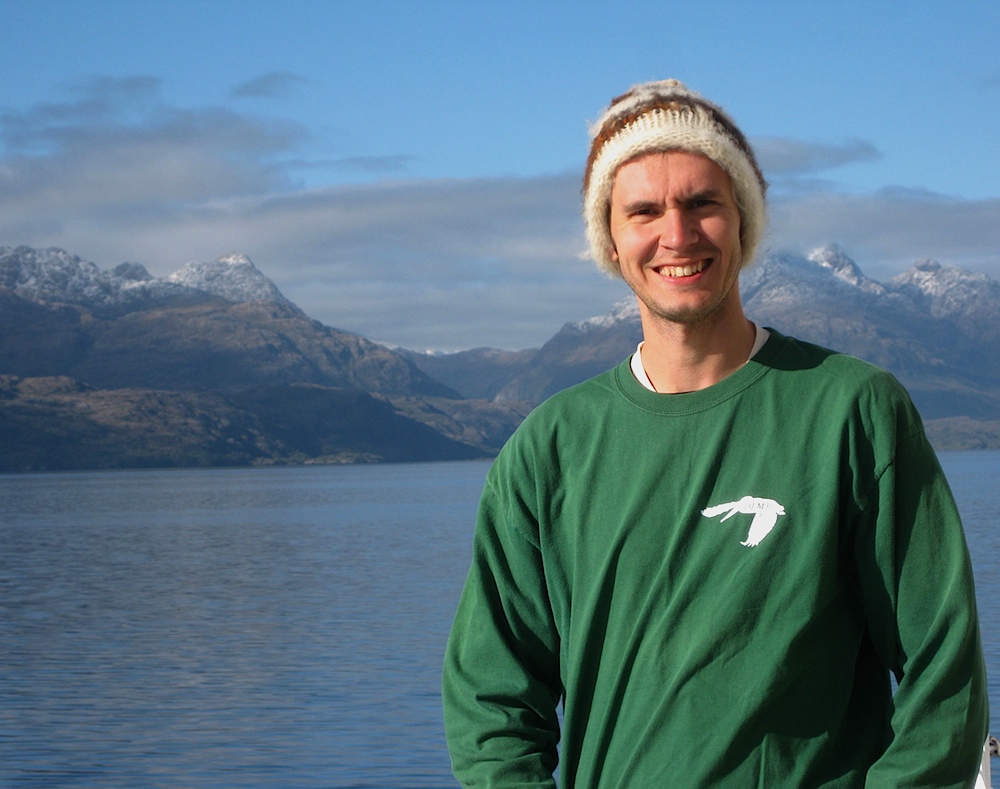Ben Grupe |
||
 |
(Graduate Student) | |
| Email: | @ucsd.edu | |
| Phone: | (858) 534-3579 | |
| Fax: | (858) 822-0562 | |
| Address: | 9500 Gilman Drive La Jolla, California 92093-0218 |
|
| Click here to download CV. | ||
| Research Interests: I am broadly interested in the community structure of benthic marine ecosystems, and my dissertation research focuses on the colonization of hard substrates at methane seeps and hydrothermal vents, both deep-sea chemosynthetic ecosystems. We have used submersibles (the HOV Alvin and ROV Jason) to perform experiments at seeps off Costa Rica and Oregon and vents along the Juan de Fuca ridge. Hard substrates are relatively rare in the deep sea, but natural varieties at chemosynthetic ecosystems include carbonate (precipitated by microbes at seeps), basalt (emitted as lava at vents), sunken wood, bones from whales and other large animals, and clam shells and worm tubes. At seeps and vents, these substrates are common and are dominated by different species than those living in the mud. I am curious how the type of substrate, the chemical environment, and distance between sites combine to create the communities and biodiversity patterns we observe at seeps and vents. Additionally, I am using patterns of stable isotopes to identify trophic relationships between microbes and invertebrates and to interpret dynamics of succession. This research will lead to a better understanding of the succession, biodiversity, and resilience of fascinating but underexplored deep-sea ecosystems that are increasingly threatened by mining, fishing, and gas industries. | ||
| Other Interests: marine community ecology; deep-sea exploration and conservation; metacommunity ecology; stable isotope ecology, invertebrate zoology; multiple predators and indirect effects; population connectivity among discrete habitats; rocky intertidal ecology; ecosystem connectivity and trophic subsidies | ||
| Education:
Ph.D. in Oceanography. 2013 (expected), Scripps Institution of Oceanography, UC San Diego. Thesis: "Heterogeneity, successional dynamics, and trophic structure of deep-sea chemosynthetic ecosystems in the East Pacific" M.S. in Biology, 2006. Oregon Institute of Marine Biology, University of Oregon. B.A. in Biology and Environmental Studies, 2003. Gettysburg College. |
||
Peer Reviewed Publications: Davidson TM, BM Grupe*. Habitat modification by bioeroding sea urchins and implications for fine-scale community structure. Marine Ecology. In press. *Equal contributions by authors. Mora C, C-L Wei, A Rollo, T Amaro, AR Baco, D Billett, L Bopp, Q Chen, M Collier, R Danovaro, AJ Gooday, BM Grupe, et al. 2013. Biotic and human vulnerability to projected changes in ocean biogeochemistry over the 21st century. PLoS Biology. 11(10): e1001682. doi:10.1371/journal.pbio.1001682. Levin LA, Orphan VJ, Rouse GW, Rathburn AE, Ussler W, Cook GS, Goffredi SK, Perez EM, Waren A, Grupe BM, Chadwick G, Strickrott B (2012) A hydrothermal seep on the Costa Rica margin: middle ground in a continuum of reducing ecosystems. Proceedings of the Royal Society B. 279: 2580-2588. doi:10.1098/rspb.2012.0205. Commito JA, S Como, BM Grupe, WE Dow. 2008. Species diversity in the soft-bottom intertidal zone: Biogenic structure, sediment, and macrofauna across mussel bed spatial scales. Journal of Experimental Marine Biology and Ecology. 366: 70-81. doi:10.1016/j.jembe.2008.07.010. Commito JA, WE Dow, BM Grupe. 2006. Hierarchical spatial structure in soft-bottom mussel beds. Journal of Experimental Marine Biology and Ecology. 330: 27-37. doi:10.1016/j.jembe.2005.12.015. Manuscripts In Review: Grupe BM, LA Levin, GF Mendoza, AR Thurber. Dynamics and trophic patterns of macrofaunal colonizers on hard substrates at methane seeps. Deep-Sea Research I. Grupe BM, ML Krach, AL Pasulka, JM Maloney, LA Levin, CA Frieder. Methane seeps enhance continental margin ecosystem services. Marine Ecology. Maloney JM, BM Grupe, AL Pasulka, D Case, K Dawson, LA Levin, N Driscoll. Transpressional segment boundaries in strike-slip fault systems offshore southern California: implications for fluid expulsion and seep habitats. Geophysical Research Letters. Sapir A, AR Dillman, SA Connon, BM Grupe, et al. Microsporidia-nematode associations in methane seeps reveal basal fungal parasitism as a characteristic of the deep sea. Frontiers in Microbiology. Commito JA, AE Commito, RV Platt, BM Grupe, WE Dow, NJ Gownaris, KA Reeves, AM Vissichelli. Recruitment facilitation and spatial pattern formation in soft-bottom mussel beds. Ecosphere. Manuscripts in prep: Grupe BM, LA Levin. Metacommunities and the maintenance of biodiversity in deep-sea chemosynthetic ecosystems. Ecology Letters. To be submitted winter 2014. Grupe BM, VJ Orphan, LA Levin. Beta diversity patterns and functional trophic niches of macrofauna at a cold methane seep. Ecology. To be submitted spring 2014. Levin LA, JP Gonzalez, GF Mendoza, BA Jellison, A Waren, AR Thurber, BM Grupe. Microbial engineering of authigenic carbonate supports unique deep-sea ecosystems. In preparation. Grupe BM. Microhabitat impacts growth, morphology, and population structure of an intertidal bioeroding sea urchin. Marine Ecology Progress Series. To be submitted July 2014. Grupe BM, AL Shanks. Trait-mediated indirect interactions between marine organisms benefit terrestrial predators. Ecology. To be submitted July 2014. | ||